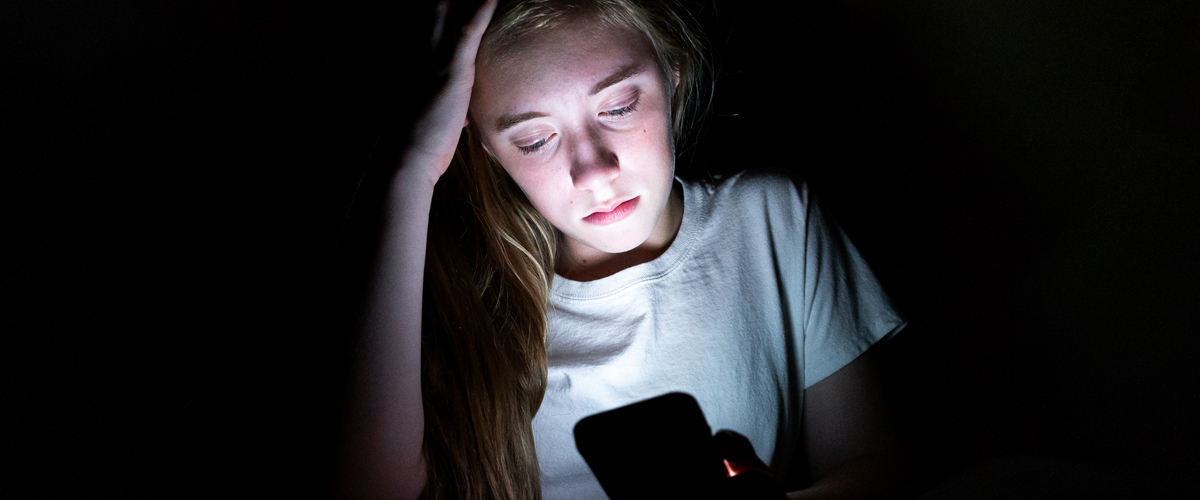Is Social Media Threatening Teens’ Mental Health and Well-being?
Too much time spent on social media could increase depression, anxiety, and social isolation, especially among young people.


Twelve and a half years old. That’s the average age at which a child opens a social media account. Growing research finds that the more time spent on social media, the more likely a person will experience mental health symptoms like anxiety, isolation, and hopelessness. And according to one recent study, high levels of social media use over the span of four years was associated with increased depression among middle and high school youths.
Health Matters spoke with Dr. Anne Marie Albano, co-clinical director of the Youth Anxiety Center at NewYork-Presbyterian and professor of medical psychology in psychiatry at Columbia University Vagelos College of Physicians and Surgeons, to understand just how harmful social media can be, and how to use it in a healthier way.
How is social media impacting young people’s mental health?
There are youth, especially those with social anxiety or depression, who may have a tendency to spend more time online and reduce their real, face-to-face contact with other folks. When an individual is not engaging in the world in a healthy way – interacting with others, managing themselves in challenging situations, whether it’s in classes or speaking up in class, going on interviews, dealing with conflict with peers – and instead increase their online presence, this can exacerbate their feelings of alienation, hopelessness, isolation, anxiety, and depression.
Can you describe how the “culture of comparison” mindset can be particularly damaging?
Any kid who is prone to concerns about their self-image and who they are, who is anxious about fitting in or what other people think about them, will inevitably compare themselves to the number of likes, friends, or followers other people have when they go online. They are looking at these sites through a negative lens of, “I’m never going to be as good as these people.” That mindset puts them at risk of increasing depression and isolation, and these are all factors that can contribute to feelings of suicide, especially when bullying gets added to the mix.
Who is most at risk for cyberbullying?
The more you’re online, the more chances there are of being bullied or harassed or something negative happening. While we don’t have data that determines which gender gets bullied more, per se, we do know that LGBTQ youth are at a higher risk of being targeted and bullied online.
“According to a Pew Research study, 45% of teens admit that they are online “almost constantly.””— Dr. Anne Marie Albano
How much time is too much time on social media?
According to a Pew Research study, 45% of teens admit that they are online “almost constantly.” So, if kids are online less than a couple of hours a day, they’re doing really well. But for those who spend three to six hours or more a day, that’s when they’re getting into iffy territory. It’s interfering with the time they could be spending with other people or doing things that help with their developmental growth, like engaging in school and extracurricular activities.
Engaging in the world around you and having social interaction with others help to develop a sense of being part of the community and doing things that enhance your feelings of competency around other people. This engagement is extremely beneficial for your personal growth and development, and it doesn’t happen when you’re online.
How does social media impact those with attention-deficit disorders?
Data show that those with ADHD (attention-deficit hyperactivity disorder) can fall into the rabbit hole of more time on social media and less time being in the world. This is especially true when it comes to gaming, because of the way that gaming programs are created; they directly affect the reinforcement systems in the brain in such a way that they’re very stimulating and exciting. When you’re participating in online gaming, you’re experiencing things that make you feel good about yourself, but in reality you’re in isolation from actual face-to-face interactions with people.
Why is social isolation dangerous?
Because we live in a social world. It’s healthy for an individual to have at least one or two friends who listen to you, whom you can engage with, and have fun with. And isolation, especially isolation where you are in a world of watching Netflix, scrolling Instagram, or gaming, will increase anxiety and this sensation of unreality, which can give you a false sense of the way the world really works. If you stay online, you may get a false sense that the world is too hurtful or dangerous. A kid might feel, “There’s nothing out there for me. I can’t do anything. I might as well just lose myself in another season of whatever show this is.” And that’s not healthy. You don’t become a productive, contributing member of society.
How does social media impact sleep?
We know that using screens directly impacts your ability to get good quality of sleep. The bottom line is technology keeps you awake. The artificial light arouses your brain and disrupts the production of melatonin to induce sleep. Studies have shown that sleep deprivation is linked to increased anxiety, stress, depression, and also substance abuse. That’s why it’s so important to disconnect from all screens an hour or more before it’s time to go to sleep.
This is a big thing for the college students I work with. Many of them sleep with their phones either next to their beds or under their pillows. So, it’s vibrating or dinging all through the night, keeping them awake. Part of this is attributed to the notion of FOMO, or fear of missing out.
How is FOMO harmful?
Other than keeping you tethered to your phone all day every day, this fear of missing out encourages young people to constantly try to build up their social media profile in some way, which makes them take risks that can then put them in an awkward position or lead to bullying.

Dr. Anne Marie Albano
Are some social media platforms worse than others?
The honest truth is that there is risk with any platform. Whether it’s swiping on a dating app or posting YouTube videos, there will always be a risk, so it’s important to have a healthy relationship with it early on.
What are some strategies to help create a healthier relationship with social media?
In our program for social anxiety at the Columbia University Clinic for Anxiety and Related Disorders, we teach teenagers and young adults how to create healthy boundaries: We work with them on what’s within their comfort zone, what makes sense when it comes to posting and liking other people’s posts, and how to stay safe and avoid buying into risky gimmicks or stunts that may be trending. We also work on how to respond to comments while ignoring others that may be inappropriate and learning when to block people.
We also teach young people how to set limits on social media use. Mealtimes are a great time to put the phones away. Another healthy habit is to set a time each night when you’ll put all the screens away to give yourself enough time to wind down and prepare the body for sleep. The other thing is getting exercise every day. We teach kids to use what we call “Grandma’s rule” of “First eat your spinach, then you can have ice cream.” So in this case, we teach kids to first go exercise or do their homework or whatever activity that is healthy for them, then they can open up social media.
What can parents do to help?
Parents will have to monitor and learn how to limit social media and overall screen time with their kids, starting at an early age. I think parents need to use parental controls until they know that their child is mature enough to manage their own accounts. So, it’s a matter of raising kids with strong family values and staying involved. Parents also have to model putting the phones and screens away themselves. When your kid comes to talk with you at the end of a school day, put the phone down and listen. Modeling this good behavior is critical.
What are some positive aspects of social media?
When used well, social media can help youth connect in the real world, whether it’s meeting up with like-minded kids, advancing their education, or engaging in healthy interests like art, music, or cooking classes.
Avoiding social media altogether is nearly impossible these days; plus, it’s where many people find out about local events and activities — like art, music, cooking, hiking clubs, book clubs, you name it — that help them get out and socialize in the world. So, we want people on social media, but we want them to use it wisely.
Anne Marie Albano, Ph.D. is co-clinical director of the Youth Anxiety Center at NewYork-Presbyterian, professor of medical psychology in psychiatry at Columbia University Vagelos College of Physicians and Surgeons, and founder of the Columbia University Clinic for Anxiety and Related Disorders. Her research is focused on the development and testing of psychosocial treatments for anxiety and mood disorders, and in understanding the impact of these disorders on developing youth. Dr. Albano has devoted her career to the study and treatment of anxiety and mood disorders in children, adolescents, and young adults. She is an expert diagnostician and cognitive behavioral therapist.

